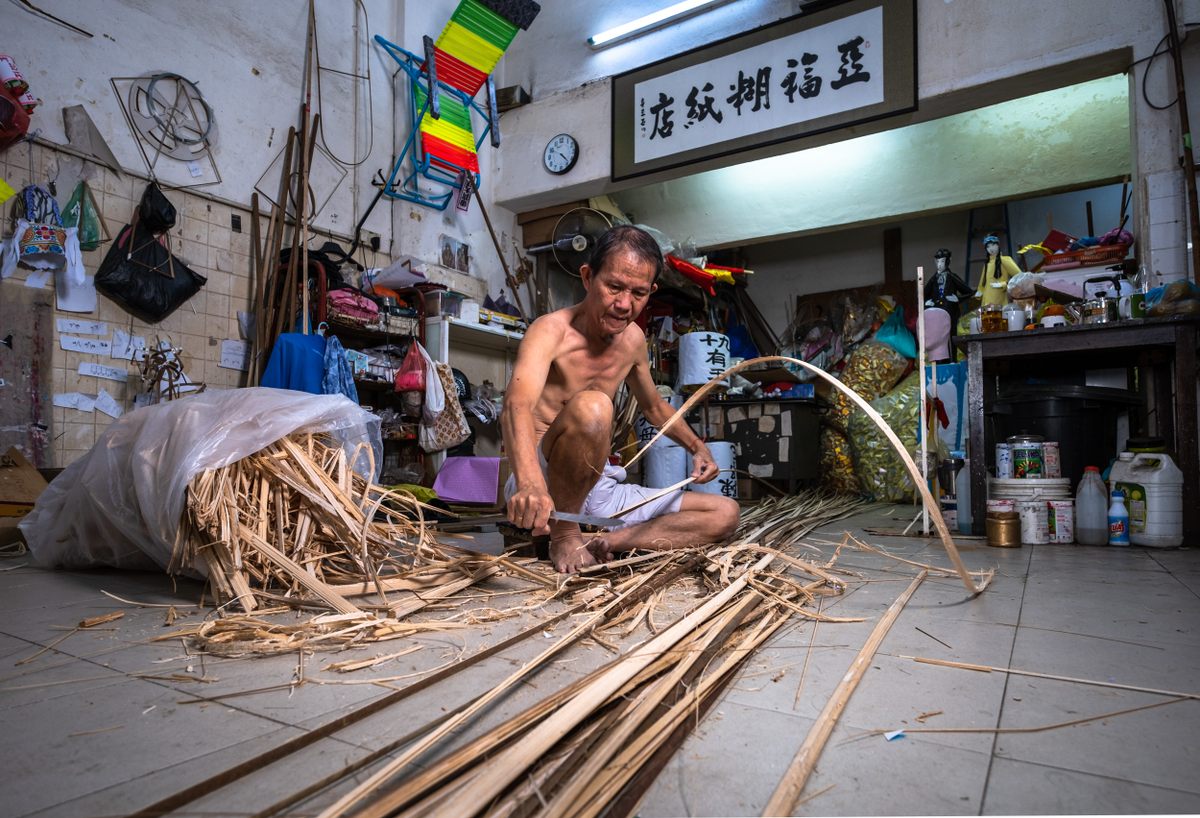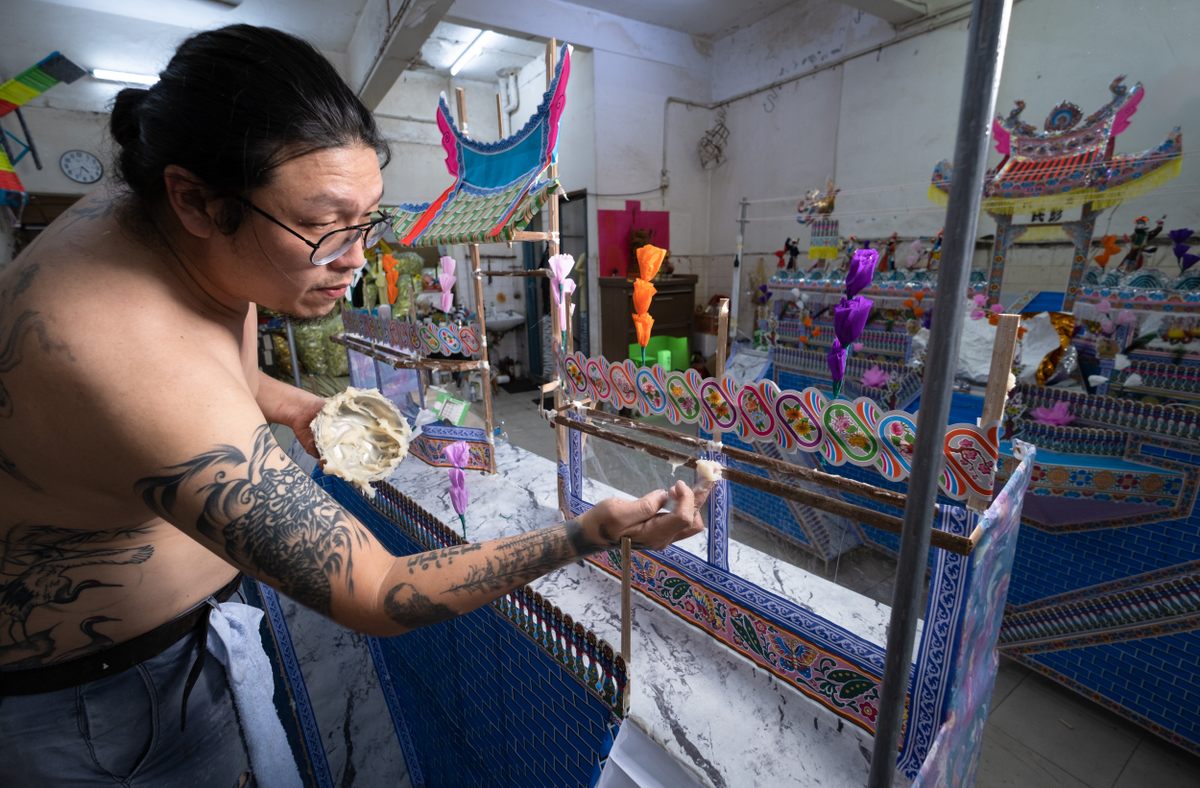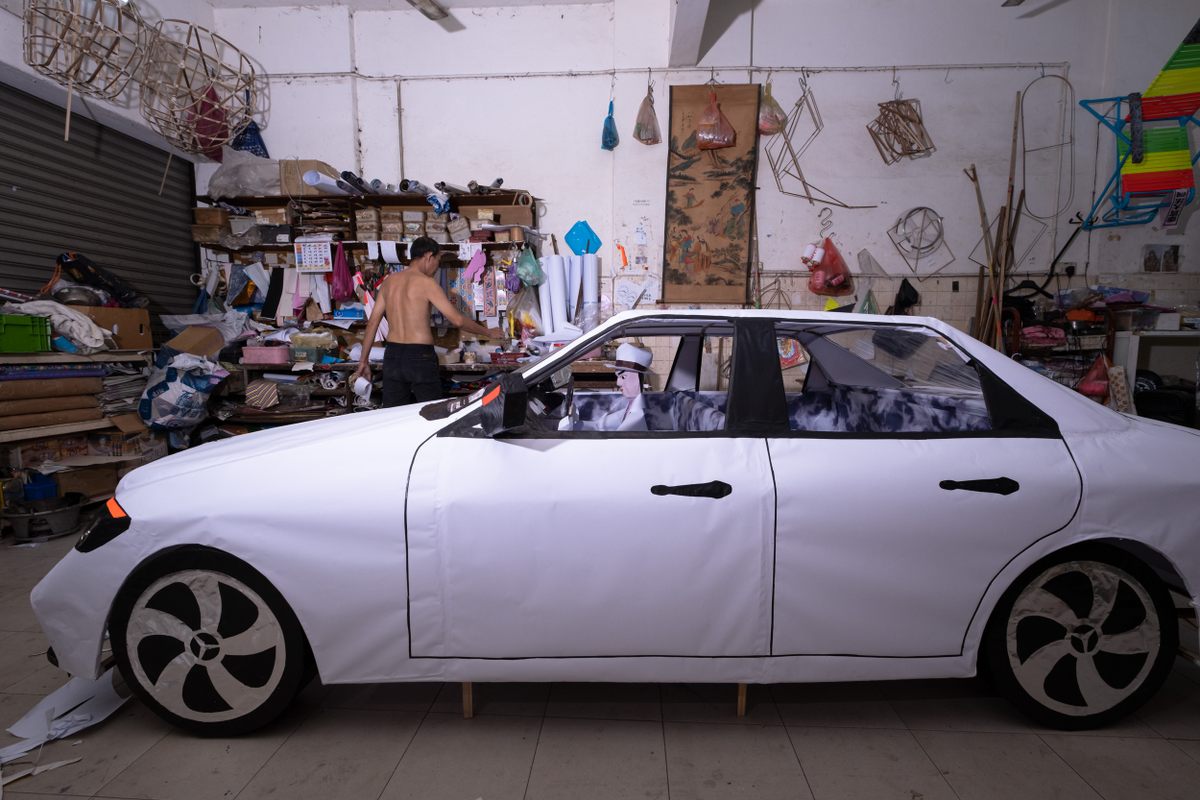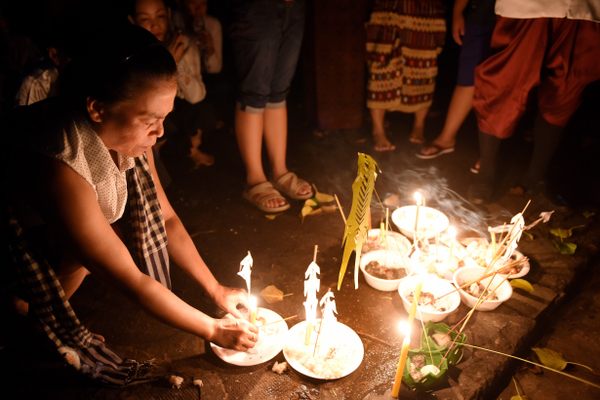
Meet the Punk Rocker Building Life-Sized Paper Effigies for Malaysia’s Ghosts
The doom metal guitarist builds papier-mâché BMWs, iPhones, and mansions—then it all goes up in smoke.
In a cramped studio tucked into a sweltering coastal city in northwestern Malaysia, Koh Eng Keat works on the gilded roof of a seven-foot-tall papier-mâché mansion. Paper scraps and splinters of wood litter the floor around him. As he glues printed floral motifs on the mansion’s walls, the sleeve of black tattoos on his right arm flexes.
Tall, long-haired, and inked, Keat and his father Koh Ah Bah run 358 Custom Effigies Workshop out of a working-class neighborhood in George Town, the capital of the northwestern Malaysian state of Penang, which sits on the tip of Penang Island. The workshop, which his father started in 1996 and moved to its current location in 2013, is filled with strips of wood that Keat and his father bend, cut, and glue into paper effigies—everything from full-sized BMWs, iPhones, to 10-foot-tall mansions. Then during a traditional Chinese memorial service to honor the dead, all of it goes up in flames.

When he was younger, Keat wanted nothing to do with his father’s work and everything to do with Malaysia’s underground music scene. At 17, he started working in a bakery and playing the drums in the alternative rock group Hui Si Di Dai. Years later, he played drums in the hardcore punk band Weotskam and founded the doom band Coma. But 10 years ago, Keat returned to the family business—music wasn’t paying the bills and his father needed the help. Today, Keat and his father are one of only seven artisans still making paper effigies on the island.
Most of Keat and his father’s customers are ethnic Chinese people from Malaysia and Singapore who use the effigies during kong teik. Held 49 days after the death of a loved one, kong teik is a funerary ceremony practiced in Buddhism and Taoism where the living conduct rituals on behalf of the deceased. In the closing act of kong teik, papier-mâché homes, food, cell phones, and all sorts of modern luxuries are set on fire. “Chinese paper offerings are unique in being replicas of real objects that are transmitted to the world of the dead by burning,” says anthropologist Jean DeBernardi of the University of Alberta, Canada, author of The Way that Lives in the Heart: Chinese Popular Religion and Spirit Mediums in Penang, Malaysia.
In Taoism, Buddhism, and traditional Chinese folk religions, a soul can only be reincarnated after passing through diyu (“earth prison” in Mandarin Chinese), a subterranean labyrinth of chambers traditionally divided into ten courts of hell. A judge rules over each court, where they oversee the purging of a different sin. “Some items are burned during the kong teik ritual to help [the dead] in their passage through the courts of hell,” says DeBernardi.

After a soul is purged of all their sins, they enter yin jian, an underworld filled with mountains and caves where souls wait to be reincarnated. Keat explains that the burning of a paper mansion guarantees a departed soul’s spot in this “space of transition,” while burning additional paper effigies ensures the dead “have their wants and needs looked after in the afterlife,” says Bernardi.
Paper effigy burning arrived in Penang in the late 19th century when Chinese migrants began moving to colonial British Malaya. At the time, every single detail of paper effigies, from the tiniest ornamental flower to figures’ eyes and limbs, were entirely handmade.
Today, artisans save time by cutting and pasting paper printed with patterns and human figures, replacing the need to hand paint and craft every part of the massive, life-sized effigies. Keat and his father make and sell effigies for anything the dead may need in the afterlife—iPhones, DVD players, laptop computers, luxury cars, and motorbikes, among others.

Koh Ah Bah, Keat’s father, “opened his shop in 1996 when his master, Wong Su Wing, passed away,” says Keat. Soon after, “[He] forced me into part-time child labor because he didn’t have enough manpower,” quips Keat, who began working on effigies when he was 10 years old.
Despite his line of work, Keat doesn’t believe in an afterlife. It’s something that makes him well-suited to the effigy-making business. “People are not interested in this career,” he says. “It’s funeral work, so most of the Chinese are pantang,” a Malay word that means, in this context, superstitious of death. “It’s taboo for them.” But the work has never bothered Keat, who’s Malaysian Chinese himself.
Since he was 27, Keat has also sold coffins and worked as a mortician to tap more widely into the earthly business of death. “I’ve been dressing and applying makeup to dead bodies for years,” he says. “I am real death metal.”

Buyers from Malaysia, Singapore, and Taiwan find Keat’s business on Facebook commissioning him and his father to make all sorts of custom pieces. In September 2022, he sold his largest piece to date—a 15-foot tall statue of the Chinese king of hell, Tai Su Yeah, to burn during one coastal Malaysian town’s Hungry Ghost Festival.
While the massive figure took him about a week to complete, Keat can churn out more standard pieces in a couple of hours. When pressed for time, he can prepare the whole inner frame of a standard seven-foot-tall papier-mâché mansion in 45 minutes. “It’s a formula, like playing the blues,” he says. “You get better at it with time.”
Every paper effigy starts with a wooden frame made out of Bertam, a flexible tropical wood. Keat strips the wood’s bark into 14-foot-long bands, throwing away the pulp. He then slices, bends, and assembles the bands into a wooden frame, following a template. Effigy artisans have passed down these templates for generations. They save precious time, but “sometimes we change them because [past artisans] made things too complicated for no reason,” says Keat.

The frame’s junctions are tied with paper and then stuck together with a glue made from flour, baking soda, and a congealing agent. It’s a delicate process. “If the Bertam wood is too dark, it’s spoiled and unusable. It will break when we bend it to make round shapes,” says Keat.
The resulting wooden frames are then covered with colorful paper. Sometimes paper printed with patterns or human figures is cut and pasted onto the effigies to add additional decoration.
The hardest part of the job, says Keat, is building large objects from scratch without a template, such as motorbikes or cars. “We are the only shop on Penang Island that can still do life-sized car models,” he says. “We prefer making BMWs and Mercedes because we know the template, so we convince the customers to buy these luxury cars because, we say, their dead relatives deserve better.”

However, Keat’s current focus isn’t making paper effigies that go up in flames. Five years ago, he started crafting permanent papier-mâché figures used to decorate Taoist and Buddhist altars and temples. Keat pulls out a 16-inch-tall model of a Chinese god, who looks like he stepped right off a death metal album cover. The long-haired, dark-skinned, fierce-looking deity is Fa Zhu Gong. Once a mortal man, Fa Zhu Gong always assisted those in need; Now as a god, he’s venerated for his good deeds and ability to exorcise demons. Keat sold his papier-mâché Fa Zhu Gong to a Singaporean businessman, fetching 3800 Malaysian ringgit, around $850—the equivalent of a white-collar salary in Malaysia.
Branching out is a must for Keat as some of the foreign cities where he sells his figurines, like Taipei, are starting to impose bans on open-air burning to combat pollution. Funerary traditions around kong teik have also begun to change. “The craft of making paper effigies is fading away as the younger generation relies more on prayers and chants by ritual specialists rather than burning paper effigies at funerals,” says ethnomusicologist Tan Sooi Beng of Penang’s University of Science Malaysia, who advocates for traditional Malaysian arts.

But Keat’s not worried. “Funeral effigies will exist as long as there are Chinese people,” he says. “This tradition is going places. My father’s master’s figures are in the Peranakan Museum in Penang, and his own work reached the archives of the British Museum.”
As for Keat, work is busy. In addition to playing guitar with his band Coma, he churns out dozens of effigies every month. In this business, “there are no day offs,” he says. “People die every day, even on weekends.”























Follow us on Twitter to get the latest on the world's hidden wonders.
Like us on Facebook to get the latest on the world's hidden wonders.
Follow us on Twitter Like us on Facebook